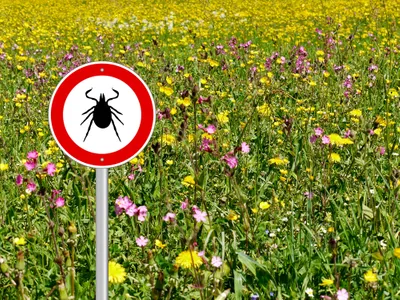Enjoying a hike through the forest is a great way to get exercise and enjoy the splendor of nature, but there are dangers lurking along the trails. Lyme disease, which is caused by the bacteria Borrelia burgdorferi, is the most common tick-borne infection in North America. The disease, which is quite serious and can cause a range of symptoms that affect the skin, joints, and nervous systems. The bacteria are transmitted through the bite of an infected black-legged tick.
The primary host of ticks are small rodents like mice, small mammals like squirrels and raccoons, deer, and birds. Predominantly between April and September, tick season is in full bloom just as everyone is enjoying the great outdoors, but there are ways to help you reduce your risk of getting a tick-borne disease. Here are six ways to avoid summer tick bites while hiking…
1. Educate Yourself
Before you venture out on the trails, know what to look for, where to expect ticks and how to avoid them. Ticks live in moist and humid environments, especially near wooded and grassy areas. Hiking through leaf litter, shrubs, tall grassy meadows, and forests can increase your chances of a tick bite.
You may not even know you’ve been bitten, until you notice a small, red rash appear. Over the next few days, the tell-tale red, bulls-eye pattern, with a red outer ring surrounded by a clear area becomes apparent. Flu-like symptoms follow—fever, chills, body aches, headache, and fatigue. If you suspect you have been bitten by a tick, a trip to the doctor is imperative as soon as possible. Treatment for Lyme disease is most effective when started early.
2. Always Walk in the Center of Trails
To avoid contact with ticks while hiking, walk in the centre of the trail and avoid overhanging bushes and branches. Don’t stroll through grasslands. Ticks can’t jump or fly but they will let themselves drop onto a potential host upon contact of the vegetation they’re resting on. Sunny, dry areas can still harbour ticks, but there are less common than damp and shady spots.
Avoid tick-infested areas whenever possible; some conversations areas and public trails inform visitors if ticks are known to be in the area, especially if the area has a dense deer population. Pay attention to these warnings and try a different trail or park instead.
2. Repel the Bugs
Ticks are small arachnids with eight legs. They range in colour from shades of brown, reddish brown, and black. They can vary in size from a pin head to a pencil eraser and once they find a host, they migrate to armpits, behind the knees and legs, the groin, and hair line, but they can bite and latch on anywhere your skin is exposed. A tick bite can be relatively harmless, unless it’s infected with Lyme disease.
Insecticides containing Diethy-meta-toluamide (DEET) can be used to repel ticks, but the American Academy of Pediatrics has advised against using insect repellents with DEET concentration higher than 30-percent, especially on children. Other insect repellants and some essential oils can provide some protection, but ticks do have a higher tolerance to insecticides than other insects like mosquitoes. Always follow the instructions on the insect repellant you’re using and apply to any exposed skin.
3. Cover Up
It may be hot and humid outside, but wearing long pants and long sleeves can help prevent tick bites because more of your skin is covered. You can even go as far at tucking your pant legs into your socks. To avoid overheating, choose light weight and breathable fabrics. Insect repellants can be sprayed on clothing for added protection, but be aware that some products stain fabrics.
Proper footwear is a hiking essential, but wearing closed-toes shoes can also help to prevent tick bites on your toes and feet. A hat that covers your ears will prevent ticks from falling onto your head and shoulders.
4. The Color of Your Clothes Can Attract Ticks
It may seem like an odd piece of advice, but wearing white or light colored clothing can actually help you detect and identify the nymphal ticks, which are about the size and colour of a poppy seed. Since they’re easily spotted on a white shirt, you can brush them off before they find skin.
That having been said, ticks are actually attracted to light colors. So dark coloured clothing can also help deter them. Whatever color of clothing you wear, lightly spraying insect repellant on your clothes can help prevent tick bites.
5. Check Your Clothes for Ticks
Once you get home from your hike, it’s important to inspect your clothing, shoes, hat and any hiking gear like a backpack for any unwanted hitchhikers. Remove all clothing and check your body for ticks, especially under the arms, in and around the ears, behind the knees, between the legs, and around the head. Don’t forget to check your dog if he was your hiking companion.
Your clothes should be immediately thrown into the washing machine, but remember, ticks can survive the wash, but they can’t survive the dry heat from a dryer. Ticks are vulnerable from drying out, so if you don’t have time to wash and dry your clothes, a quick dry cycle in the dryer will take care of them.
6. Shower after hiking
After you’ve taken care of your clothing and inspected your body, a shower within 2-hours of coming home can reduce your risk of tick bites and Lyme disease. The water will wash away any ticks that haven’t yet attached themselves to your skin.
If you do notice a tick that has already latched on, remove the tick using fine-tipped tweezers. If the tick is removed within 24-hours, the chances of contracting Lyme disease are extremely small, but you should watch for symptoms and consult your doctor if you’ve had a tick bite and show signs of a rash or fever.










